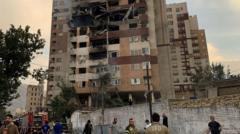*On June 13, 2025, an extensive Israeli military operation paralyzed Iran’s defense structure by targeting major military and nuclear sites, claiming the lives of leading Iranian officials. This marks a significant turn in Middle-Eastern tensions, prompting concerns of imminent retaliation and wider conflict.*
**Massive Israeli Airstrikes Target Iran's Military Command and Nuclear Facilities**

**Massive Israeli Airstrikes Target Iran's Military Command and Nuclear Facilities**
*Israel launched unprecedented airstrikes on Iran, striking key military and nuclear sites, resulting in the deaths of top Iranian generals and scientists. The escalation raises fears of regional conflict.*
June 13, 2025, 1:40 a.m. ET – In a dramatic escalation, Israel's military conducted a historic series of airstrikes against Iran at dawn on Friday, asserting it was a preemptive measure to thwart potential threats from Iran's advancing nuclear program. The strikes reportedly targeted military bases.
Residents across Tehran witnessed massive blasts, with extensive damage reported in several neighborhoods. Eyewitness accounts included two Israeli jets overhead attacking military installations, with smoke and flames visible from major urban areas. According to Israeli military sources, the strikes involved over 200 aircraft and targeted upwards of 100 sites including critical nuclear facilities, air defense systems, and homes of high-ranking military officials.
Among the casualties, three of Iran’s top military leaders have been confirmed dead, including Maj. Gen. Mohammad Bagheri, who served as chief of the armed forces and General Hossein Salami, head of the Islamic Revolutionary Guards Corps. Additionally, key nuclear scientists, including Mohammad Mehdi Tehranchi and Fereydoun Abbasi, were also killed, significantly impacting Iran’s capability to develop nuclear weapons.
Prime Minister Benjamin Netanyahu defended the operation as vital for Israel’s survival, stating, “We struck at the heart of Iran’s nuclear and missile programs.” Conflicts escalated swiftly, with fears mounting over possible retaliatory actions by Iran and the potential for an all-out war in the region.
The Supreme Leader of Iran, Ayatollah Ali Khamenei, condemned the strikes, pledging that Israel would face a "harsh punishment." Iranian officials have indicated a retaliatory response is imminent, with military planning actively underway.
On the international front, the United States distanced itself from the operations, with Secretary of State Marco Rubio insisting America was not involved. However, Iranian officials accused the U.S. of complicity, claiming the operation could not have occurred without American authorization.
The geopolitical tides shifted as conflicting narratives emerged over the involvement of the U.S. in Israel's aggressive stance towards Iran. As Iranian officials prepare for rapid military countermeasures, both nations brace for the possible consequences of escalated hostility, raising alarms about a broader Middle Eastern conflict.
U.S. military preparedness has been escalated following the strikes, with American forces in the region on high alert. The ongoing failure of nuclear negotiations between the U.S. and Iran complicates the situation further, as an anticipated diplomatic meeting set for Oman remains uncertain.
As tensions mount, global markets react adversely, with rising oil prices reflecting fears of instability in the region following the strikes against Iran’s military infrastructure. The situation remains fluid, with both nations preparing for potential conflict, leaving the world on edge regarding the shifting balance of power in the Middle East.
The potential for consequences affecting both U.S. interests and regional alliances looms large, as the fallout from these unprecedented military actions unfolds.
Residents across Tehran witnessed massive blasts, with extensive damage reported in several neighborhoods. Eyewitness accounts included two Israeli jets overhead attacking military installations, with smoke and flames visible from major urban areas. According to Israeli military sources, the strikes involved over 200 aircraft and targeted upwards of 100 sites including critical nuclear facilities, air defense systems, and homes of high-ranking military officials.
Among the casualties, three of Iran’s top military leaders have been confirmed dead, including Maj. Gen. Mohammad Bagheri, who served as chief of the armed forces and General Hossein Salami, head of the Islamic Revolutionary Guards Corps. Additionally, key nuclear scientists, including Mohammad Mehdi Tehranchi and Fereydoun Abbasi, were also killed, significantly impacting Iran’s capability to develop nuclear weapons.
Prime Minister Benjamin Netanyahu defended the operation as vital for Israel’s survival, stating, “We struck at the heart of Iran’s nuclear and missile programs.” Conflicts escalated swiftly, with fears mounting over possible retaliatory actions by Iran and the potential for an all-out war in the region.
The Supreme Leader of Iran, Ayatollah Ali Khamenei, condemned the strikes, pledging that Israel would face a "harsh punishment." Iranian officials have indicated a retaliatory response is imminent, with military planning actively underway.
On the international front, the United States distanced itself from the operations, with Secretary of State Marco Rubio insisting America was not involved. However, Iranian officials accused the U.S. of complicity, claiming the operation could not have occurred without American authorization.
The geopolitical tides shifted as conflicting narratives emerged over the involvement of the U.S. in Israel's aggressive stance towards Iran. As Iranian officials prepare for rapid military countermeasures, both nations brace for the possible consequences of escalated hostility, raising alarms about a broader Middle Eastern conflict.
U.S. military preparedness has been escalated following the strikes, with American forces in the region on high alert. The ongoing failure of nuclear negotiations between the U.S. and Iran complicates the situation further, as an anticipated diplomatic meeting set for Oman remains uncertain.
As tensions mount, global markets react adversely, with rising oil prices reflecting fears of instability in the region following the strikes against Iran’s military infrastructure. The situation remains fluid, with both nations preparing for potential conflict, leaving the world on edge regarding the shifting balance of power in the Middle East.
The potential for consequences affecting both U.S. interests and regional alliances looms large, as the fallout from these unprecedented military actions unfolds.



















